Accelerating Broadband DOA Estimation: A Real-Valued and Coherent Sparse Bayesian Approach for 5G Sensing
Abstract
1. Introduction
- Coherent Focusing for Broadband-to-Narrowband Consistency: To overcome propagation path discrepancies across frequency components, we develop a MUSIC-like focusing algorithm that generates a single, equivalent narrowband covariance matrix. This transformation establishes spatial information consistency for broadband signals, laying the foundation for the successful application of high-resolution sparse methods in what was previously an incoherent problem.
- Efficient Real-Valued Bayesian Solver Formulation: To tackle the high computational cost of complex-valued Bayesian inference, we pioneer a novel real-valued formulation of the sparse recovery problem. By transforming the core equations into a reduced-dimension real-valued domain, our approach significantly decreases the computational complexity associated with matrix operations without sacrificing accuracy.
- Root-Finding-Based Convergence Acceleration: We introduce a significant acceleration to the iterative solver by recasting the hyperparameter optimization as a root-finding task. Moving beyond traditional update schemes, we formally prove that our proposed hyperparameter update function possesses the necessary monotonicity, thereby enabling a faster and more robust convergence mechanism inspired by fast variational learning principles.
2. Signal Modeling
2.1. Echo-Based Angle Measurement Principle
2.2. Signal Model
3. Existing DOA Estimation Methods
3.1. Traditional DOA Estimation Methods
3.2. DOA Estimation Based on SBL
4. Proposed Method
4.1. Focusing Processing for Broadband OFDM Signals
4.2. Real-Valued Transformation
4.3. Bayesian Inference
4.4. Fast Variational Bayesian Inference (FVSBL)
5. Numerical Evaluation
5.1. Experimental Setup
| Algorithm 1 Proposed RC-FVSBL for Broadband DOA Estimation |
| 1: Input: Received multi-subcarrier data for ; Array manifolds ; Angular grid . |
| 2: Output: Estimated DOAs . |
| ▷ Stage 1: Coherent Focusing |
| 3: Compute preliminary DOA estimates (e.g., using a MUSIC-like spectrum). |
| 4: Compute focusing matrices using via Equation (20). |
| 5: Compute the focused covariance matrix via Equation (23). |
| ▷ Stage 2: Real-Valued Transformation |
| 6: Vectorize the focused matrix: . |
| 7: Construct the complex dictionary and whiten the model to get and via Equations (24)–(30). |
| ▷ Stage 3: Fast Variational Bayesian Solver (FVSBL) |
| 8: Initialize: Hyperparameters , posterior mean , covariance . |
| 9: . |
| 10: repeat |
| 11: Update posterior covariance via Equation (38). |
| 12: Update posterior mean via Equation (37). |
| 13: Update hyperparameters via the root-finding update rule Equation (42). |
| 14: . |
| 15: until convergence criterion is met (e.g., ) |
| ▷ Stage 4: DOA Estimation |
| 16: Identify the peak locations in the final posterior mean . |
| 17: return |
5.1.1. Simulation Environment and Signal Model
5.1.2. Data Pre-Processing and Algorithm Parameter Settings
5.2. RMSE Performance Analysis
5.2.1. Performance with Dual Signal Sources
5.2.2. Performance with Three Signal Sources
5.2.3. RMSE Versus Number of Snapshots
5.3. Resolution and Convergence Analysis
5.3.1. Resolution Capability
5.3.2. Convergence Speed
5.4. Computational Complexity Analysis
5.4.1. Theoretical Complexity Analysis
- Posterior Covariance Update: The most computationally intensive step is the calculation of the posterior covariance matrix, . The matrix, , has dimensions , where , and is of size (N + 1). The matrix inversion of this matrix dominates this step, requiring , or simply floating-point operations (FLOPs).
- Posterior Mean Update: The calculation of the posterior mean, , involves a matrix-vector product, which has a complexity of . This is computationally less demanding than the matrix inversion.
- Hyperparameter Update (FVSBL Root-Finding): The FVSBL update for the hyperparameters, , involves solving N + 1 independent, single-variable root-finding problems (from Equation (A7)). Each root can be found efficiently using numerical methods like Newton’s method, which typically converges in a small, constant number of steps. Therefore, the total complexity for this update step is O (N).
- Acceleration via Real-Valued Transformation (Constant Factor Reduction): A key component of our method is the real-valued transformation applied to the sparse recovery problem. This transformation yields a substantial computational advantage that is not reflected in the order of complexity. While the complexity of the matrix inversion remains, the nature of the underlying arithmetic is fundamentally changed. Standard complex matrix operations, which involve numerous complex multiplications (each comprising four real multiplications), are replaced by operations in the real domain. This substitution drastically reduces the number of floating-point operations required for each step of the matrix inversion, leading to a significant, constant-factor reduction in runtime.
- Acceleration via Fast Variational Bayesian Learning (FVSBL): The most significant source of acceleration stems from the FVSBL framework, which addresses the primary bottleneck of conventional SBL methods—the slow convergence rate. As demonstrated in our convergence analysis (Section 5.3.2), the FVSBL’s monotonic update scheme enables our algorithm to converge in a very small, constant number of iterations (typically fewer than ten). This contrasts sharply with traditional SBL implementations, such as rootSBL, which often require hundreds of iterations to reach a solution. Consequently, while the per-iteration complexity is , the total computational cost, which is the product of the per-iteration complexity and the number of iterations, is vastly lower for our method. This dramatic reduction in the required number of iterations is the principal driver of the overall acceleration.
5.4.2. Empirical Runtime Comparison Within the SBL Framework
5.5. Robustness Analysis Against Array Imperfections
6. Conclusions
Author Contributions
Funding
Data Availability Statement
Conflicts of Interest
Nomenclature
| Symbol | Description |
| Number of array sensors | |
| Number of signal sources | |
| Number of snapshots | |
| Number of OFDM subcarriers | |
| Number of angular grid points | |
| Signal wavelength | |
| Focused (equivalent narrowband) covariance matrix | |
| Complex dictionary matrix in the sparse model | |
| Whitened and real-valued dictionary matrix | |
| Sparse vector of signal powers on the angular grid | |
| Posterior mean and covariance of | |
| Vector of hyperparameters controlling sparsity | |
| Noise variance |
Appendix A
Proof of Monotonicity
References
- Qian, C.; Huang, L.; Sidiropoulos, N.D.; Xie, L. Enhanced PUMA for direction-of-arrival estimation and its performance analysis. IEEE Trans. Signal Process. 2016, 64, 4127–4137. [Google Scholar] [CrossRef]
- Roy, R.; Kailath, T. ESPRIT-estimation of signal parameters via rotational invariance techniques. IEEE Trans. Acoust. Speech Signal Process. 1989, 37, 984–995. [Google Scholar] [CrossRef]
- Schmidt, R. Multiple emitter location and signal parameter estimation. IEEE Trans. Antennas Propag. 1986, 34, 276–280. [Google Scholar] [CrossRef]
- Shan, T.-J.; Wax, M.; Kailath, T. On spatial smoothing for direction-of-arrival estimation of coherent signals. IEEE Trans. Acoust. Speech Signal Process. 1985, 33, 806–811. [Google Scholar] [CrossRef]
- Zhou, Z.; Jin, T.; Li, Y.; Zhang, M.; So, H.C. Enhanced Coherent DOA Estimation in Low SNR Environments Through Contrastive Learning. IEEE Trans. Instrum. Meas. 2025, 74, 1–21. [Google Scholar] [CrossRef]
- Chen, T.; Kornblith, S.; Norouzi, M.; Hinton, G. A simple framework for contrastive learning of visual representations. In Proceedings of the 37th International Conference on Machine Learning, Vienna, Austria, 13–18 July 2020; pp. 1597–1607. [Google Scholar]
- Deng, J.; Shi, W.; Zhang, J.; Ai, B. Supervised contrastive CSI representation learning for massive MIMO positioning. IEEE Commun. Lett. 2022, 26, 1799–1803. [Google Scholar] [CrossRef]
- Gong, X.; Lu, A.-A.; Fu, X.; Zhang, H. Semisupervised Representation Contrastive Learning for Massive MIMO Fingerprint Positioning. IEEE Internet Things J. 2023, 11, 14870–14885. [Google Scholar] [CrossRef]
- Li, Y.; Zhou, Z.; Chen, C.; Jin, T.; Zhang, M. An efficient convolutional neural network with supervised contrastive learning for multi-target DOA estimation in low SNR. Axioms 2023, 12, 862. [Google Scholar] [CrossRef]
- Villani, M.J.; Schoots, N. Any deep relu network is shallow. arXiv 2023, arXiv:2306.11827. [Google Scholar] [CrossRef]
- Cong, J.; Wang, X.; Huang, M.; Shan, T. Robust DOA estimation method for MIMO radar via deep neural networks. IEEE Sens. J. 2020, 21, 7498–7507. [Google Scholar] [CrossRef]
- Cao, Y.; Lv, T.; Lin, Z.; Gao, H.; Yang, F. Complex ResNet aided DoA estimation for near-field MIMO systems. IEEE Trans. Veh. Technol. 2020, 69, 11139–11151. [Google Scholar] [CrossRef]
- Wu, X.; Yang, X.; Jia, X.; Zhang, Y.; Zhang, Z. A gridless DOA estimation method based on convolutional neural network with Toeplitz prior. IEEE Signal Process. Lett. 2022, 29, 1247–1251. [Google Scholar] [CrossRef]
- Lee, K. Deep learning-aided coherent direction-of-arrival estimation with the FTMR algorithm. IEEE Trans. Signal Process. 2022, 70, 1118–1130. [Google Scholar]
- Papageorgiou, G.K.; Sellathurai, M.; Eldar, Y.C. Deep networks for direction-of-arrival estimation in low SNR. IEEE Trans. Signal Process. 2021, 69, 3714–3729. [Google Scholar] [CrossRef]
- Zhu, Z.; Chen, C.; Yang, B. Angle of Arrival Estimation with Transformer: A Sparse and Gridless Method with Zero-Shot Capability. arXiv 2024, arXiv:2408.09362. [Google Scholar] [CrossRef]
- Zheng, R.; Sun, S.; Liu, H.; Chen, H.; Li, J. Interpretable and efficient beamforming-based deep learning for single-snapshot DOA estimation. IEEE Sens. J. 2023, 24, 22096–22105. [Google Scholar] [CrossRef]
- Stoica, P.; Babu, P.; Li, J. SPICE: A sparse covariance-based estimation method for array processing. IEEE Trans. Signal Process. 2010, 59, 629–638. [Google Scholar] [CrossRef]
- Dai, J.; Xu, X.; Zhao, D. Direction-of-arrival estimation via real-valued sparse representation. IEEE Antennas Wirel. Propag. Lett. 2013, 12, 376–379. [Google Scholar] [CrossRef]
- Hu, N.; Ye, Z.; Xu, X.; Tian, Y.; Lan, P. DOA estimation for sparse array via sparse signal reconstruction. IEEE Trans. Aerosp. Electron. Syst. 2013, 49, 760–773. [Google Scholar] [CrossRef]
- Liu, Z.-M.; Huang, Z.-T.; Zhou, Y.-Y. Array signal processing via sparsity-inducing representation of the array covariance matrix. IEEE Trans. Aerosp. Electron. Syst. 2013, 49, 1710–1724. [Google Scholar] [CrossRef]
- Liu, Z.-M.; Huang, Z.-T.; Zhou, Y.-Y.; Zheng, N. Direction-of-arrival estimation of noncircular signals via sparse representation. IEEE Trans. Aerosp. Electron. Syst. 2012, 48, 2690–2698. [Google Scholar] [CrossRef]
- Malioutov, D.; Cetin, M.; Willsky, A.S. A sparse signal reconstruction perspective for source localization with sensor arrays. IEEE Trans. Signal Process. 2005, 53, 3010–3022. [Google Scholar] [CrossRef]
- Zhang, L.; Dai, L. Image reconstruction of electrical capacitance tomography based on an efficient sparse Bayesian learning algorithm. IEEE Trans. Instrum. Meas. 2022, 71, 1–14. [Google Scholar] [CrossRef]
- Pan, H.; Yang, Y.; Zheng, J.; Cheng, J.; Chen, X. Symplectic transformation based variational Bayesian learning and its applications to gear fault diagnosis. Measurement 2019, 147, 106827. [Google Scholar] [CrossRef]
- Wang, Q.; Yu, H.; Li, J.; So, H.C.; Wan, Q. Sparse Bayesian learning using generalized double Pareto prior for DOA estimation. IEEE Signal Process. Lett. 2021, 28, 1744–1748. [Google Scholar] [CrossRef]
- Dai, J.; So, H.C. Real-valued sparse Bayesian learning for DOA estimation with arbitrary linear arrays. IEEE Trans. Signal Process. 2021, 69, 4977–4990. [Google Scholar] [CrossRef]
- Guo, Q.; Xin, Z.; Zhou, T.; Huang, T.; Yang, X. Off-grid space alternating sparse Bayesian learning. IEEE Trans. Instrum. Meas. 2023, 72, 1–10. [Google Scholar] [CrossRef]
- Gerstoft, P.; Mecklenbräuker, C.F.; Xenaki, A.; Nannuru, S. Multisnapshot sparse Bayesian learning for DOA. IEEE Signal Process. Lett. 2016, 23, 1469–1473. [Google Scholar] [CrossRef]
- Park, Y.; Meyer, F.; Gerstoft, P. Sequential sparse Bayesian learning for doa. In Proceedings of the 2020 54th Asilomar Conference on Signals, Systems, and Computers, Pacific Grove, CA, USA, 1–4 November 2020; pp. 78–81. [Google Scholar]
- Ahmad, Z.; Song, Y.; Du, Q. Wideband DOA estimation based on incoherent signal subspace method. COMPEL-Int. J. Comput. Math. Electr. Electron. Eng. 2018, 37, 1271–1289. [Google Scholar] [CrossRef]
- Valaee, S.; Kabal, P. Wideband array processing using a two-sided correlation transformation. IEEE Trans. Signal Process. 1995, 43, 160–172. [Google Scholar] [CrossRef]
- Hung, H.; Kaveh, M. Focussing matrices for coherent signal-subspace processing. IEEE Trans. Acoust. Speech Signal Process. 1988, 36, 1272–1281. [Google Scholar] [CrossRef]
- Doron, M.A.; Weiss, A.J. On focusing matrices for wide-band array processing. IEEE Trans. Signal Process. 1992, 40, 1295–1302. [Google Scholar] [CrossRef]
- Swingler, D.N.; Krolik, J. Source location bias in the coherently focused high-resolution broad-band beamformer. IEEE Trans. Acoust. Speech Signal Process. 1989, 37, 143–145. [Google Scholar] [CrossRef]
- Valaee, S.; Kabal, P. The optimal focusing subspace for coherent signal subspace processing. IEEE Trans. Signal Process. 1996, 44, 752–756. [Google Scholar] [CrossRef][Green Version]
- Zhou, W.; Zhang, R.; Chen, G.; Wu, W. Integrated sensing and communication waveform design: A survey. IEEE Open J. Commun. Soc. 2022, 3, 1930–1949. [Google Scholar] [CrossRef]
- Liu, R.; Li, M.; Liu, Q.; Swindlehurst, A.L. DOA estimation-oriented joint array partitioning and beamforming designs for ISAC systems. IEEE Trans. Wirel. Commun. 2024, 24, 2052–2066. [Google Scholar] [CrossRef]
- Ottersten, B.; Stoica, P.; Roy, R. Covariance matching estimation techniques for array signal processing applications. Digit. Signal Process. 1998, 8, 185–210. [Google Scholar] [CrossRef]
- Chen, F.; Dai, J.; Hu, N.; Wu, Z.; Xu, X. Sparse Bayesian learning for off-grid DOA estimation with nested arrays. Digit. Signal Process. 2018, 82, 187–193. [Google Scholar] [CrossRef]
- Tzikas, D.G.; Likas, A.C.; Galatsanos, N.P. The variational approximation for Bayesian inference. IEEE Signal Process. Mag. 2008, 25, 131–146. [Google Scholar] [CrossRef]
- Möderl, J.; Leitinger, E.; Fleury, B.H.; Pernkopf, F.; Witrisal, K. Fast variational block-sparse Bayesian learning. arXiv 2023, arXiv:2306.00442. [Google Scholar] [CrossRef]

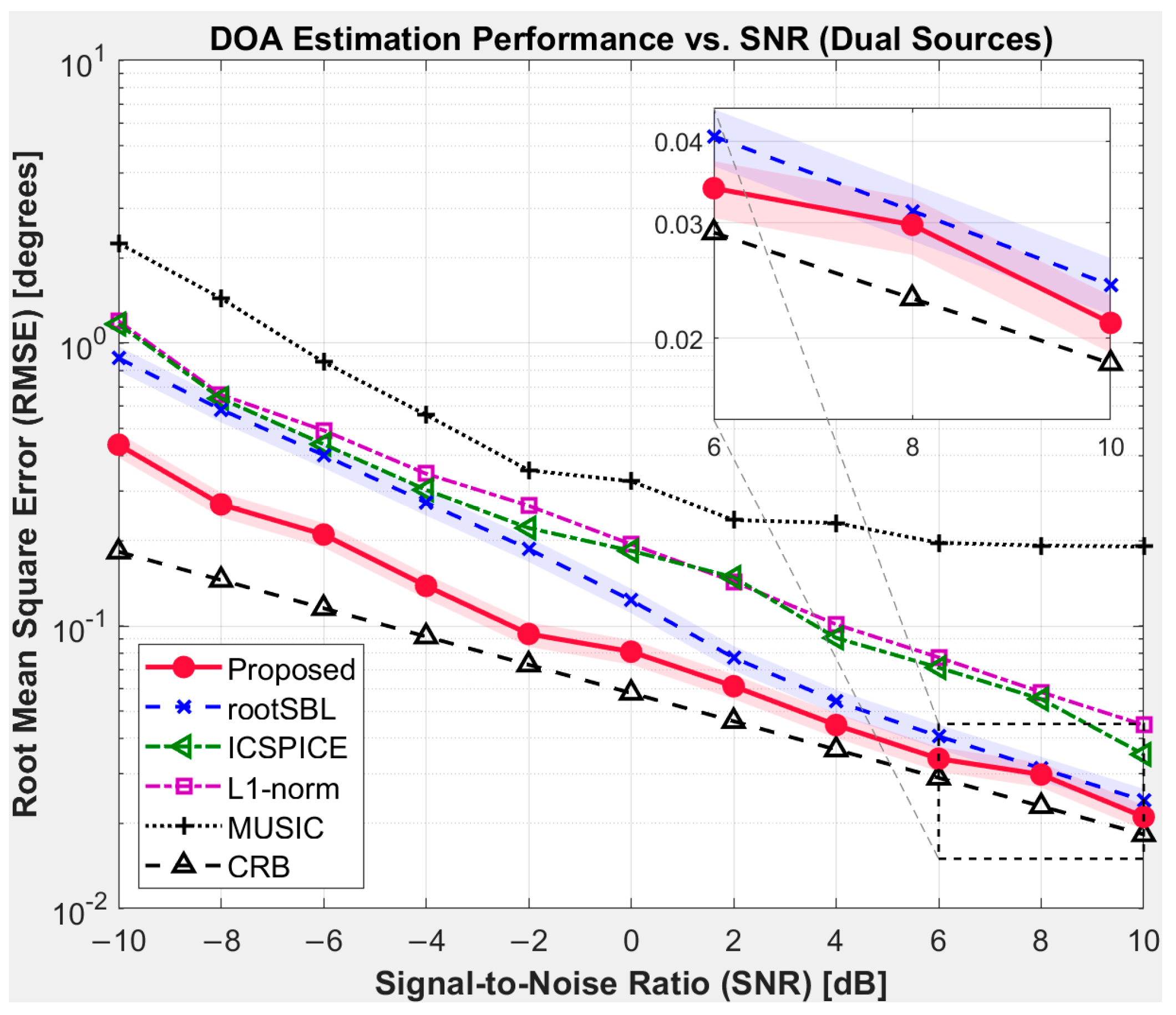
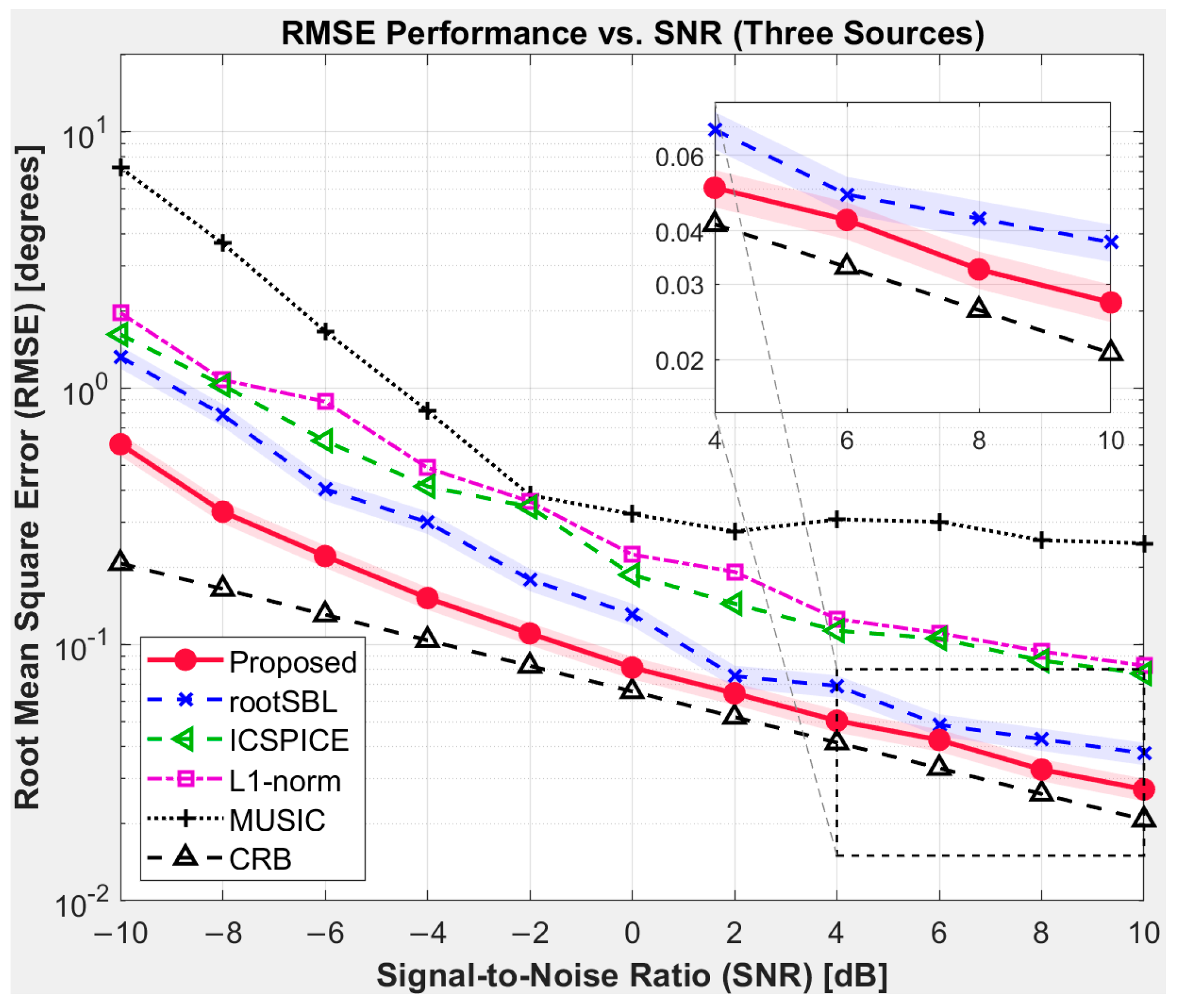
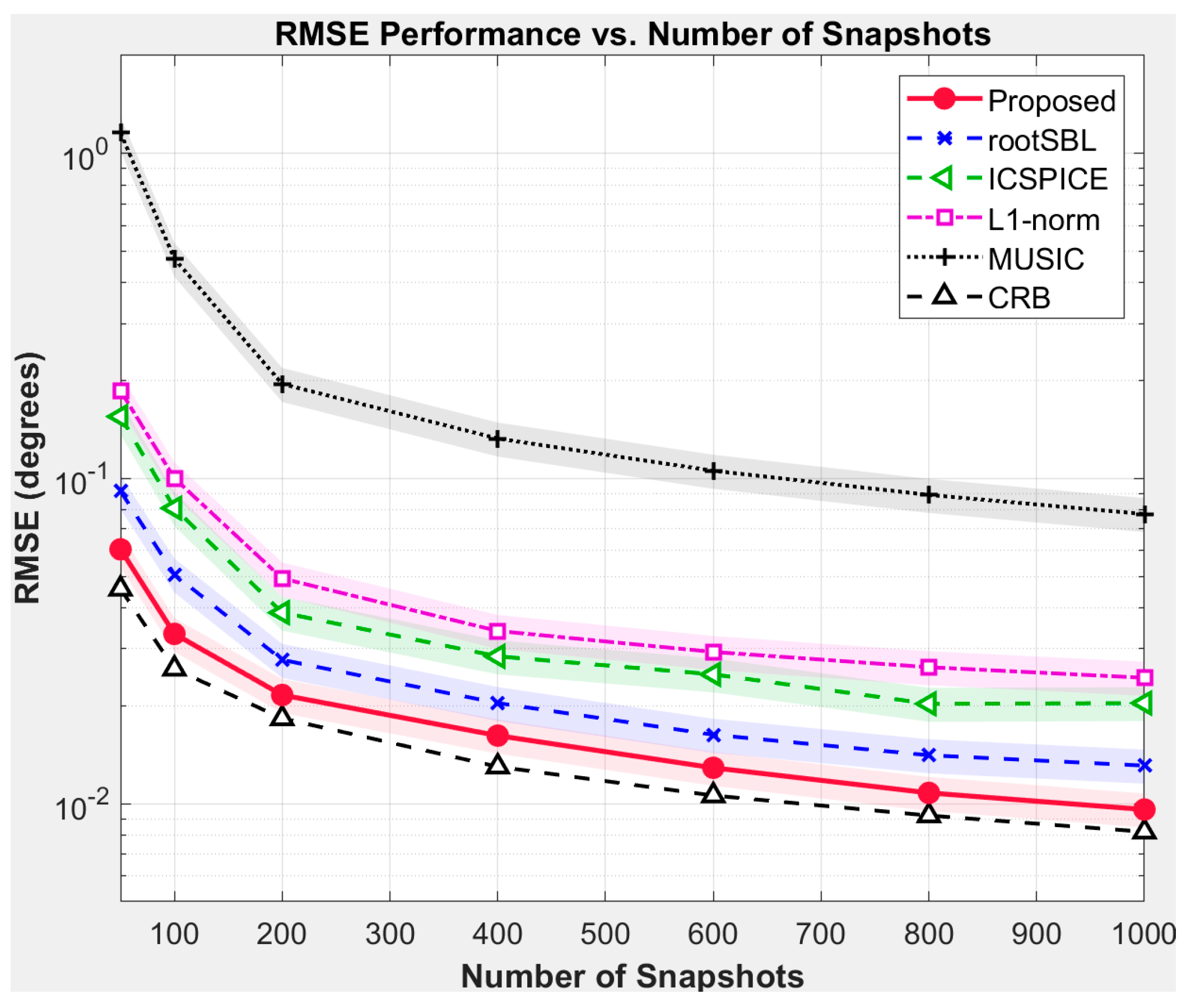
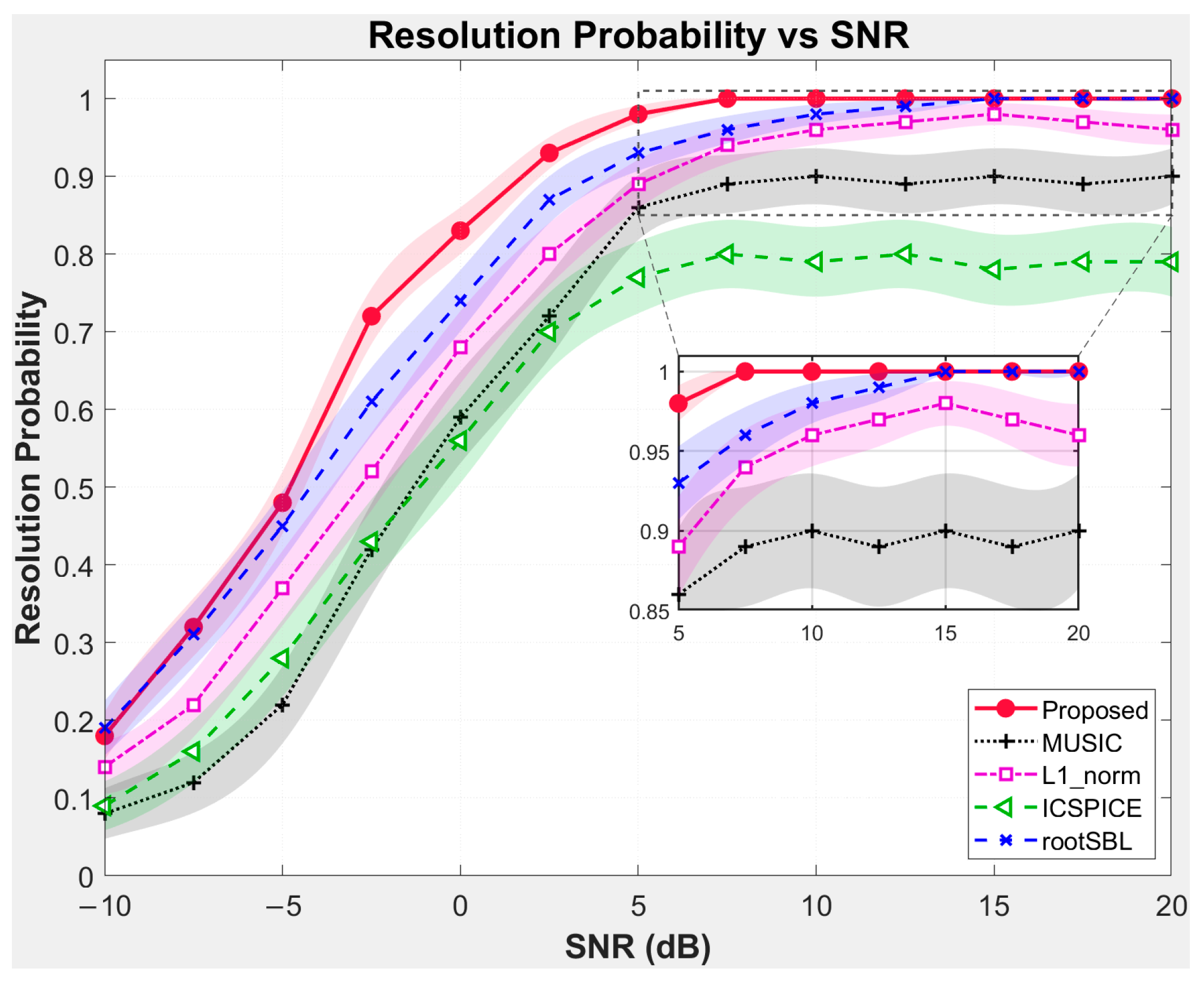

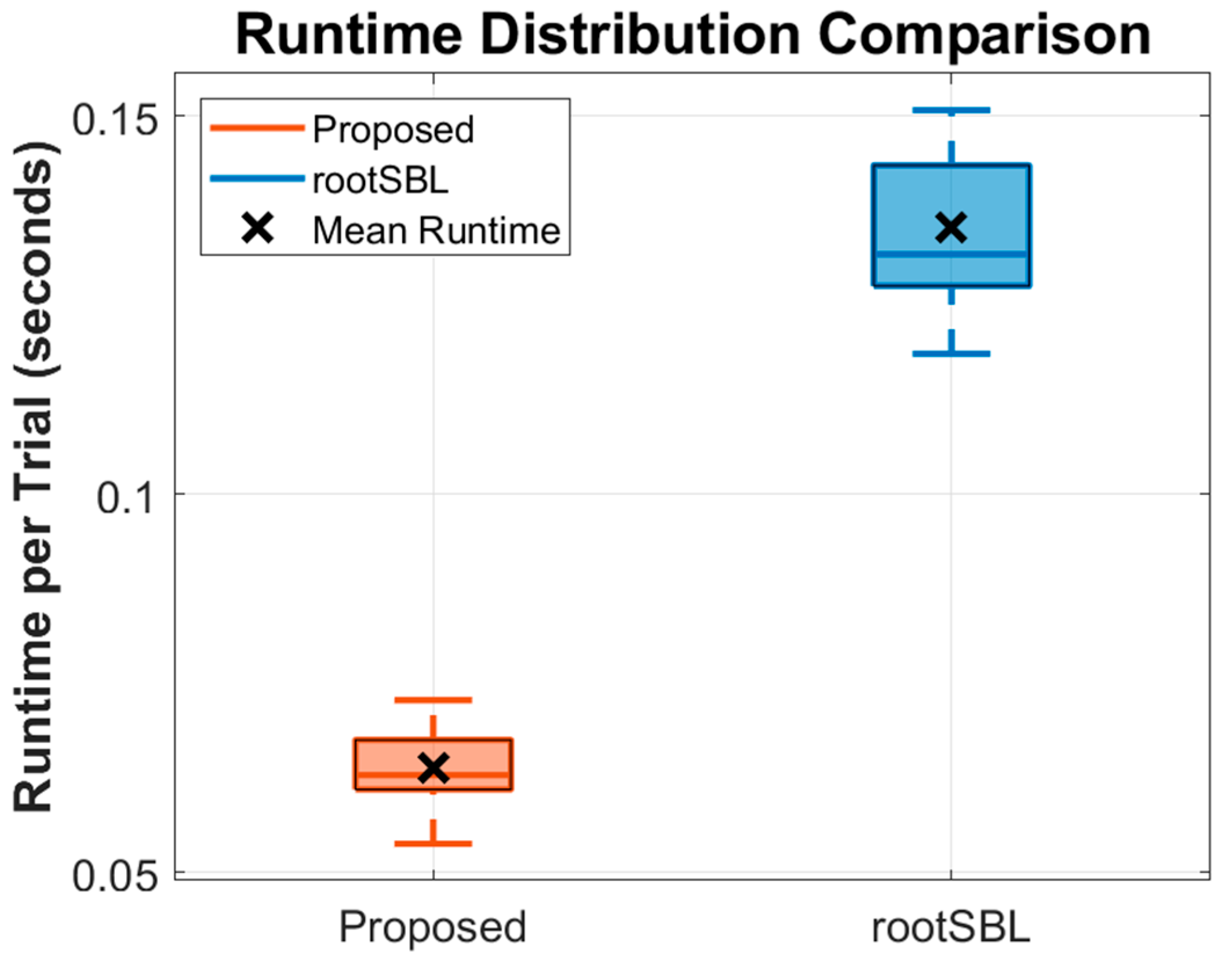
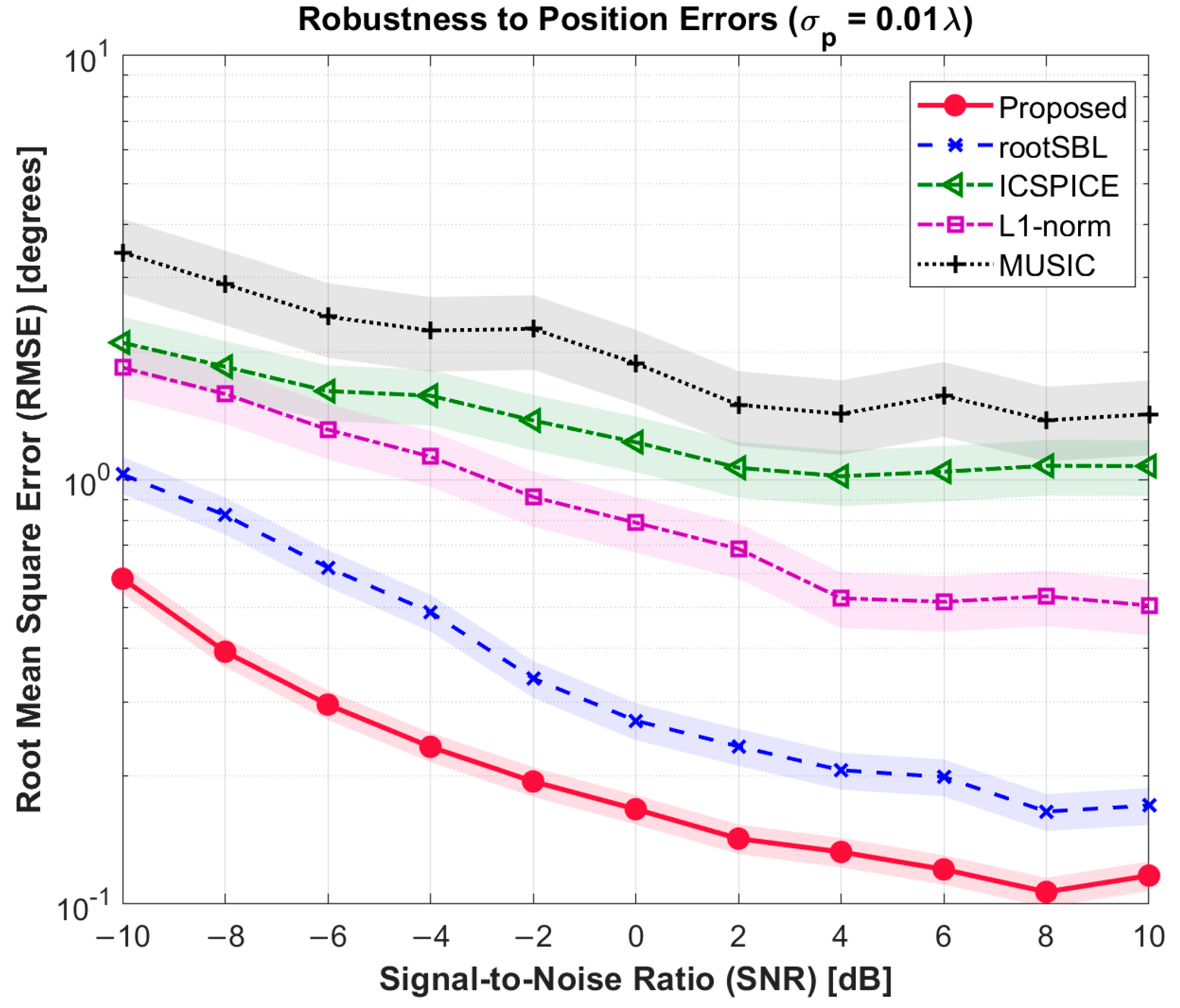
| Algorithm | Parameter | Value/Setting | Rationale |
|---|---|---|---|
| MUSIC | Source Number (K) | Assumed to be known a priori. | Standard requirement |
| L1-norm | Regularization Parameter () | Tuned via cross-validation | Ensures optimal performance |
| ICSPICE | Maximum Iterations | 500 | Sufficient for convergence |
| rootSBL | Maximum Iterations | 500 | Sufficient for convergence |
| RC-FVSBL | Non-informative prior |
| Algorithm | Dominant Operation | Per-Iteration Complexity (FLOPs) |
|---|---|---|
| rootSBL | ||
| RC-FVSBL (proposed) |
Disclaimer/Publisher’s Note: The statements, opinions and data contained in all publications are solely those of the individual author(s) and contributor(s) and not of MDPI and/or the editor(s). MDPI and/or the editor(s) disclaim responsibility for any injury to people or property resulting from any ideas, methods, instructions or products referred to in the content. |
© 2025 by the authors. Licensee MDPI, Basel, Switzerland. This article is an open access article distributed under the terms and conditions of the Creative Commons Attribution (CC BY) license (https://creativecommons.org/licenses/by/4.0/).
Share and Cite
Tong, X.; Hu, Y.; Deng, Z.; Hu, E. Accelerating Broadband DOA Estimation: A Real-Valued and Coherent Sparse Bayesian Approach for 5G Sensing. Electronics 2025, 14, 3174. https://doi.org/10.3390/electronics14163174
Tong X, Hu Y, Deng Z, Hu E. Accelerating Broadband DOA Estimation: A Real-Valued and Coherent Sparse Bayesian Approach for 5G Sensing. Electronics. 2025; 14(16):3174. https://doi.org/10.3390/electronics14163174
Chicago/Turabian StyleTong, Xin, Yinzhe Hu, Zhongliang Deng, and Enwen Hu. 2025. "Accelerating Broadband DOA Estimation: A Real-Valued and Coherent Sparse Bayesian Approach for 5G Sensing" Electronics 14, no. 16: 3174. https://doi.org/10.3390/electronics14163174
APA StyleTong, X., Hu, Y., Deng, Z., & Hu, E. (2025). Accelerating Broadband DOA Estimation: A Real-Valued and Coherent Sparse Bayesian Approach for 5G Sensing. Electronics, 14(16), 3174. https://doi.org/10.3390/electronics14163174






